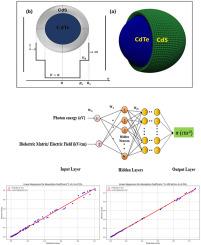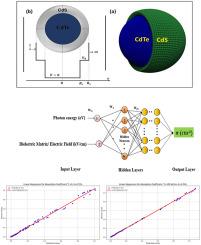CdTe/CdS量子点电场依赖吸收系数的机器学习预测
IF 9.7
2区 材料科学
Q1 MATERIALS SCIENCE, MULTIDISCIPLINARY
引用次数: 0
摘要
研究了嵌入二氧化钛(TiO2)和二氧化硅(SiO2)基质中的CdTe/CdS核壳量子点的电场诱导光吸收系数。为了模拟这些变化,我们采用了比较方法,利用人工神经网络(ANN)、决策树(DT)、随机森林回归(RFR)和光梯度增强机(LightGBM),并将它们的预测与数值有限元方法模拟进行比较。结果表明,TiO2包埋导致吸收共振的红移和振幅增大,而SiO2包埋或隔离导致吸收共振的蓝移和振幅减小。值得注意的是,随机森林回归器展示了最准确的预测,强调了机器学习在模拟和预测量子点系统光学特性方面的有效性。本文章由计算机程序翻译,如有差异,请以英文原文为准。


Machine learning prediction of electric field-dependent absorption coefficient in CdTe/CdS quantum dots
We investigated the electric field-induced optical absorption coefficient in CdTe/CdS core-shell quantum dots embedded within titanium dioxide (TiO2) and silicon dioxide (SiO2) matrices. To model these changes, we employed a comparative approach, utilizing Artificial Neural Networks (ANN), Decision Trees (DT), Random Forest Regressors (RFR), and Light Gradient Boosting Machine (LightGBM) and comparing their predictions with numerical finite element method simulations. Our findings revealed that TiO2 embedding resulted in a redshift and amplitude increase of the absorption resonance, whereas SiO2 embedding or isolation caused a blueshift and amplitude decrease. Notably, the Random Forest Regressor exhibited the most accurate predictions, underscoring the effectiveness of machine learning in simulating and predicting the optical properties of quantum dot systems.
求助全文
通过发布文献求助,成功后即可免费获取论文全文。
去求助
来源期刊

Materials Today Physics
Materials Science-General Materials Science
CiteScore
14.00
自引率
7.80%
发文量
284
审稿时长
15 days
期刊介绍:
Materials Today Physics is a multi-disciplinary journal focused on the physics of materials, encompassing both the physical properties and materials synthesis. Operating at the interface of physics and materials science, this journal covers one of the largest and most dynamic fields within physical science. The forefront research in materials physics is driving advancements in new materials, uncovering new physics, and fostering novel applications at an unprecedented pace.
 求助内容:
求助内容: 应助结果提醒方式:
应助结果提醒方式:


